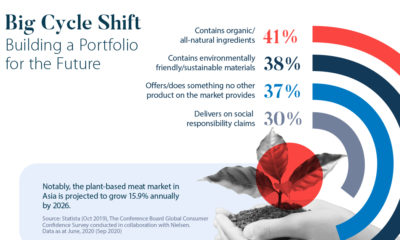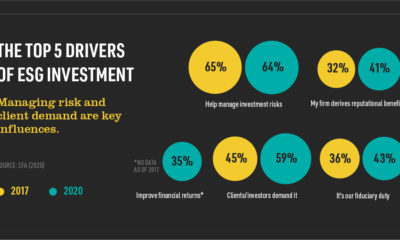This infographic is available as a poster.
Sustainable Investing Assets Worldwide (2018-2020)
Sustainable investing is top-of-mind for many investors, but how fast is it actually growing?
Between 2018 and 2020, global sustainable investing assets grew 15% to reach $35.3 trillion. This works out to more than a third of total assets under management.
In this Markets in a Minute from New York Life Investments, we explore the value and growth of sustainable investing assets across five major markets.
What is Sustainable Investing?
Sustainable investing considers environmental, social, and governance (ESG) factors in portfolio selection and management. For the purposes of this data, it is a broad definition that includes seven main approaches:
- ESG integration
- Corporate engagement & shareholder action
- Norms-based screening
- Negative/exclusionary screening
- Best-in-class/positive screening
- Sustainability themed/thematic investing
- Impact and community investing
In most regions, it is becoming increasingly common to combine several of the above strategies within the same product.
Sustainable Investing Assets by Region
Sustainable investment data comes from five major markets: the U.S., Europe, Japan, Canada, and Australasia. Currencies have been converted to U.S. dollars at the prevailing exchange rate at the day of reporting. We’ve based growth rates on U.S. dollar values.
Here is the value of sustainable investing assets in U.S dollars, sorted by asset amounts in 2020.
| Region | 2018 | 2020 | Growth Rate |
| United States | $12.0T | $17.1T | 42% |
| Europe | $14.1T | $12.0T | -15% |
| Japan | $2.2T | $2.9T | 32% |
| Canada | $1.7T | $2.4T | 43% |
| Australasia | $734B | $906B | 23% |
All 2020 assets are reported as of December 31, 2019 except for Japan which reports as of March 31, 2020. Australasia is Australia and New Zealand. In 2020, Europe includes: Austria, Belgium, Bulgaria, Denmark, France, Germany, Greece, Italy, Spain, Netherlands, Poland, Portugal, Slovenia, Sweden, the UK, Norway, Switzerland, and Liechtenstein.
The U.S. makes up almost half of global sustainable investment assets, and saw the second highest growth rate. One strong theme in the country is racial justice investing. Over 120 investors and organizations signed a call to action for the investment community to dismantle systemic racism and promote racial equity and justice. They plan to achieve this through various actions, such as hiring people of color and financing Black entrepreneurs.
Europe makes up over a third of all sustainable investing assets. The region has seen important regulatory developments, such as:
- Institutional investors, asset managers, and advisors must report on how they integrate sustainability risks and adverse impacts at the entity level
- Advisors are required to ask about their clients’ ESG preferences and advise appropriate products
While Europe saw a decline in growth from 2018-2020, this is because the region has changed how they define sustainable investing. Tighter legislation means that some products that previously qualified as sustainable may not meet the new requirements. The goal of the legislation is to create clear standards for sustainable products, promoting trust and easier access for investors.
The Mounting Pressure
Globally, the proportion of sustainable investing assets is growing. In fact, sustainable investments make up 36% of global assets under management, up from 28% in 2016.
Investment professionals say the top drivers of sustainable investing are to help manage investment risks, and because clients demand it. Not only that, the recent Intergovernmental Panel on Climate Change (IPCC) report has reinforced the importance of sustainable investments.
“The climate crisis poses enormous financial risk to investment managers, asset owners and businesses….. The public and private sector must work together to ensure a just and rapid transformation to a net-zero global economy.”
—António Guterres, UN Secretary-General




 Infographics2 years ago
Infographics2 years ago
 Markets in a Minute2 years ago
Markets in a Minute2 years ago
 Markets in a Minute2 years ago
Markets in a Minute2 years ago
 Infographics2 years ago
Infographics2 years ago
 Markets in a Minute1 year ago
Markets in a Minute1 year ago
 Infographics3 years ago
Infographics3 years ago
 Markets in a Minute2 years ago
Markets in a Minute2 years ago
 Infographics1 year ago
Infographics1 year ago




















